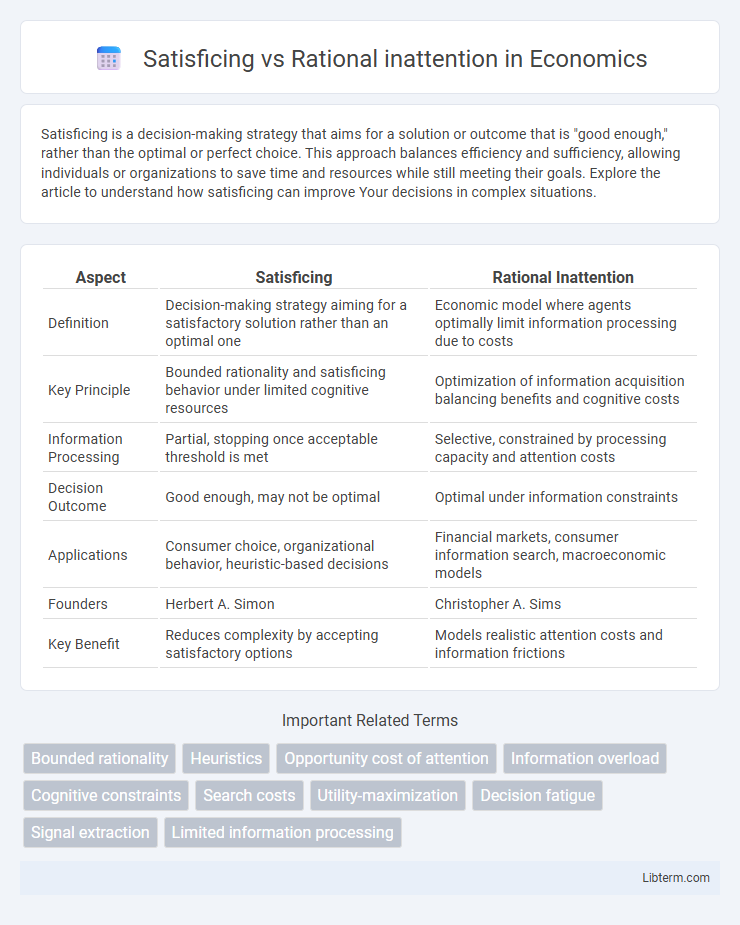Satisficing is a decision-making strategy that aims for a solution or outcome that is "good enough," rather than the optimal or perfect choice. This approach balances efficiency and sufficiency, allowing individuals or organizations to save time and resources while still meeting their goals. Explore the article to understand how satisficing can improve Your decisions in complex situations.
Table of Comparison
| Aspect | Satisficing | Rational Inattention |
|---|---|---|
| Definition | Decision-making strategy aiming for a satisfactory solution rather than an optimal one | Economic model where agents optimally limit information processing due to costs |
| Key Principle | Bounded rationality and satisficing behavior under limited cognitive resources | Optimization of information acquisition balancing benefits and cognitive costs |
| Information Processing | Partial, stopping once acceptable threshold is met | Selective, constrained by processing capacity and attention costs |
| Decision Outcome | Good enough, may not be optimal | Optimal under information constraints |
| Applications | Consumer choice, organizational behavior, heuristic-based decisions | Financial markets, consumer information search, macroeconomic models |
| Founders | Herbert A. Simon | Christopher A. Sims |
| Key Benefit | Reduces complexity by accepting satisfactory options | Models realistic attention costs and information frictions |
Introduction to Satisficing and Rational Inattention
Satisficing is a decision-making strategy where individuals accept an adequate solution rather than optimizing for the best possible outcome, reducing cognitive effort and time spent on choices. Rational inattention describes a framework where decision-makers limit the amount of information they process due to cognitive or resource constraints, balancing the cost of acquiring information against the expected benefits. Both concepts explore bounded rationality, emphasizing how limitations in attention and information processing shape real-world decision-making behaviors.
Defining Satisficing: Origins and Applications
Satisficing, a decision-making strategy introduced by Herbert A. Simon in 1956, involves selecting an option that meets a predefined threshold of acceptability rather than seeking the optimal solution. This concept contrasts with rational inattention, where individuals allocate limited cognitive resources selectively, often ignoring some information due to processing constraints. Satisficing applies broadly across economics, psychology, and behavioral science, providing insights into bounded rationality and real-world decision behaviors under complexity and uncertainty.
The Concept of Rational Inattention Explained
Rational inattention is a decision-making theory that explains how individuals allocate limited cognitive resources when processing information under constraints. Unlike satisficing, which involves settling for a decision that is "good enough," rational inattention models the cost-benefit trade-off between acquiring detailed information and the cognitive effort required. This concept highlights how people optimally ignore some information to focus on the most relevant data, balancing accuracy and cognitive efficiency in economic and behavioral contexts.
Key Differences Between Satisficing and Rational Inattention
Satisficing involves making decisions by selecting the first acceptable option that meets a set threshold, prioritizing speed over exhaustive optimization, while rational inattention centers on allocating limited cognitive resources to process only the most relevant information, optimizing decisions under information constraints. The key difference lies in the decision strategy: satisficing emphasizes a satisficing heuristic to reduce effort, whereas rational inattention models incorporate information processing costs and partial attention to maximize expected utility. Satisficing is often heuristic-driven and boundedly rational, whereas rational inattention employs formal economic models based on information theory and signal processing to explain decision-making under cognitive limitations.
Cognitive Costs: Information Processing in Decision-Making
Satisficing and rational inattention both address cognitive costs in decision-making by limiting information processing to manageable levels. Satisficing involves selecting the first option that meets a satisfactory threshold to minimize cognitive effort, while rational inattention optimizes attention allocation by selectively processing valuable information under cognitive constraints. These models highlight how individuals balance information acquisition costs and decision accuracy in complex environments.
Behavioral Economics: Satisficing vs Rational Inattention
In behavioral economics, satisficing describes decision-making where individuals choose the first option meeting acceptable criteria rather than optimizing, conserving cognitive resources. Rational inattention theory explains how people selectively ignore some information to reduce processing costs, balancing potential benefits against mental effort. Both concepts emphasize bounded rationality, highlighting how limited attention and cognitive constraints influence economic choices under uncertainty.
Real-World Examples of Satisficing and Rational Inattention
Consumers deciding on a smartphone often exhibit satisficing by choosing a model that meets essential criteria without exhaustive comparison, saving time and cognitive effort. Investors practicing rational inattention selectively overlook minor market fluctuations, focusing only on significant trends to allocate their attention and resources efficiently. Drivers ignoring non-urgent traffic updates exemplify rational inattention, while shoppers opting for the first acceptable product demonstrate satisficing behavior in everyday decision-making.
Implications for Consumer Decision-Making
Satisficing leads consumers to make decisions based on satisfactory rather than optimal outcomes, reducing cognitive effort and simplifying choice under limited information. Rational inattention explains consumers' selective focus on relevant information, balancing the cost of acquiring data with potential decision improvements. These models imply that consumers often settle for good-enough options while strategically ignoring complex, costly information to maximize utility efficiently.
Strategies to Overcome Cognitive Limitations
Strategies to overcome cognitive limitations in satisficing and rational inattention involve optimizing decision-making processes by setting clear thresholds for acceptable outcomes and prioritizing relevant information. Techniques such as chunking information, employing heuristics carefully, and leveraging decision support systems help mitigate the effects of limited attention and cognitive overload. Enhancing working memory capacity and using adaptive learning algorithms can further improve focus on critical data, leading to more efficient and rational choices under constraints.
Conclusion: Choosing Between Satisficing and Rational Inattention
Choosing between satisficing and rational inattention hinges on balancing cognitive resource limitations with decision accuracy. Satisficing offers a practical strategy by settling for a "good enough" option to conserve mental effort, while rational inattention optimizes the allocation of limited attention to maximize useful information processing. Decision-makers should weigh the trade-offs between cognitive efficiency and outcome precision based on their context, constraints, and goals.
Satisficing Infographic

 libterm.com
libterm.com